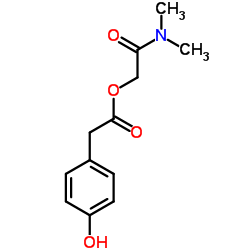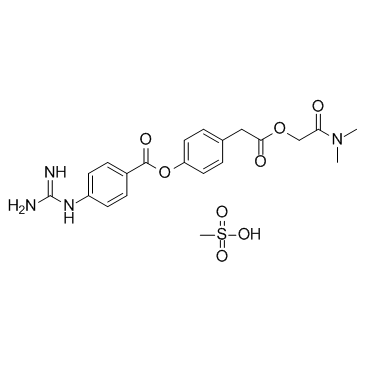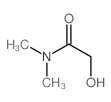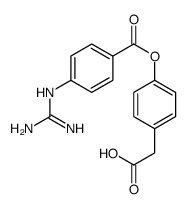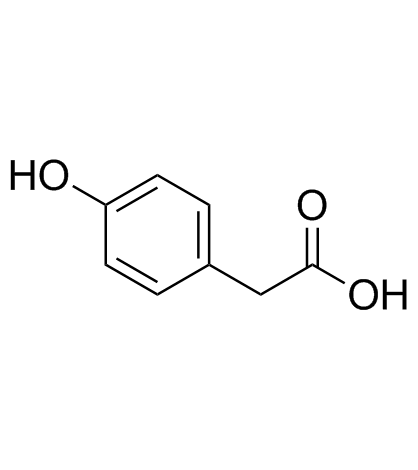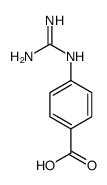This product was successfully added to cart!
品牌商品推荐
更多 >>商品详情
客户评价
| 描述 |
Camostat (FOY305; FOY-S980)甲磺酸盐是胰蛋白酶样蛋白酶抑制剂。 |
||||||||||||
|---|---|---|---|---|---|---|---|---|---|---|---|---|---|
| 相关类别 |
|
||||||||||||
| 溶解度 |
体外:
H 2 O:≥50mg / mL(101.11 mM) * “≥”表示可溶,但饱和度未知。
|
||||||||||||
| 储备液 |
|
||||||||||||
| 存储 |
|
||||||||||||
| 运输 |
室温;可能会有所不同 |
||||||||||||
| SMILES |
O=C(OCC(N(C)C)=O)CC1=CC=C(OC(C2=CC=C(NC(N)=N)C=C2)=O)C=C1.CS(=O)(O)=O |
||||||||||||
| 参考文献 |
|
||||||||||||
| 相关活性 小分子 |
磺丁醚-beta-环糊精 | 环孢菌素 | 2,7-二氯二氢代荧光黄二醋酸 | 1-甲基-4-苯基-1,2,3,6-四氢吡啶盐酸盐 | 4′,4”-双-2-咪唑啉-2-基对苯二丙烯酰苯胺二盐酸盐 | 乙莫克舍 | TD139 | Mitoquinone甲磺酸盐 | GSK2795039 | 5,5’,6,6’-四氯-1,1’,3,3’-四乙基苯并咪唑羰花青碘化物 | 胞内钙荧光探针 BAPTA-AM | AP20187 | GKT137831 | D-虫荧光素游离酸 | 野百合碱 |
| 沸点 | 634.6?C at 760 mmHg |
|---|---|
| 熔点 | 150-1550C |
| 分子式 | C21H26N4O8S |
| 分子量 | 494.518 |
| 精确质量 | 494.147125 |
| PSA | 197.56000 |
| LogP | 2.84290 |
| 外观性状 | 结晶固体 |
| 储存条件 |
在密封的贮藏器内,并放置阴凉,干燥的地方保存 |
| 稳定性 |
避免接触水 |
| 水溶解性 | 水溶性:微溶;极微溶:乙醇;不溶:乙醚 |
| 计算化学 |
1.疏水参数计算参考值(XlogP):无 2.氢键供体数量:3 3.氢键受体数量:9 4.可旋转化学键数量:9 5.互变异构体数量:4 6.拓扑分子极性表面积200 7.重原子数量:34 8.表面电荷:0 9.复杂度:695 10.同位素原子数量:0 11.确定原子立构中心数量:0 12.不确定原子立构中心数量:0 13.确定化学键立构中心数量:0 14.不确定化学键立构中心数量:0 15.共价键单元数量:2 |
| 更多 |
1. 性状:未确定 2. 密度(g/cm3 ):未确定 3. 相对蒸汽密度(g/mL,空气=1):未确定 4. 熔点(?C):150-155 5. 沸点(?C):未确定 6. 沸点(?C,5.2kPa):未确定 7. 折射率(°):未确定 8. 闪点(℉):未确定 9. 比旋光度(?):未确定 10. 自燃点或引燃温度(?C):未确定 11. 蒸气压(kPa,25?C):未确定 12. 饱和蒸气压(kPa,60?C):未确定 13. 燃烧热(KJ/mol):未确定 14. 临界温度(?C):未确定 15. 临界压力(KPa):未确定 16. 油水(辛醇/水)分配系数的对数值(25℃):未确定 17. 爆炸上限(%,V/V):未确定 18. 爆炸下限(%,V/V):未确定 19. 溶解性(mg/mL,):水:未确定 |
|
甲磺酸卡莫司他毒性英文版
|
| 符号 |


GHS07, GHS09 |
|---|---|
| 信号词 |
Warning |
| 危害声明 |
H315-H319-H335-H400 |
| 警示性声明 |
P261-P273-P305 + P351 + P338 |
| 危害码 (欧洲) |
Xi,N |
| 风险声明 (欧洲) |
R36/37/38:Irritating to eyes, respiratory system and skin . |
| 安全声明 (欧洲) |
S26-S36 |
| 危险品运输编码 | UN 3077 9 / PGIII |
| RTECS号 | UV7720000 |
| 甲磺酸卡莫司他上游产品? 1 | |
|---|---|
|
|
|
| 甲磺酸卡莫司他下游产品? 4 | |
|
|
|
ERK activation is required for CCK-mediated pancreatic adaptive growth in mice. Am. J. Physiol. Gastrointest. Liver Physiol. 307(7) , G700-10, (2014)
High levels of cholecystokinin (CCK) can stimulate pancreatic adaptive growth in which mature acinar cells divide, leading to enhanced pancreatic mass with parallel increases in protein, DNA, RNA, and…
|
|
|
Protease inhibitors targeting coronavirus and filovirus entry. Antiviral Res. 116 , 76-84, (2015)
In order to gain entry into cells, diverse viruses, including Ebola virus, SARS-coronavirus and the emerging MERS-coronavirus, depend on activation of their envelope glycoproteins by host cell proteas…
|
|
|
Correction of defective CFTR/ENaC function and tightness of cystic fibrosis airway epithelium by amniotic mesenchymal stromal (stem) cells. J. Cell. Mol. Med. 18(8) , 1631-43, (2014)
Cystic fibrosis (CF) is caused by mutations in the CF transmembrane conductance regulator (CFTR) gene, with most of the mortality given by the lung disease. Human amniotic mesenchymal stromal (stem) c…
|
|
|
Benzeneacetic acid, 4-[[4-[(aminoiminomethyl)amino]benzoyl]oxy]-, 2-(dimethylamino)-2-oxoethyl ester, methanesulfonate (1:1) |
|
Camostat Mesylate |
|
[4-[2-[2-(dimethylamino)-2-oxoethoxy]-2-oxoethyl]phenyl] 4-(diaminomethylideneamino)benzoate,methanesulfonic acid |
|
4-{2-[2-(Dimethylamino)-2-oxoethoxy]-2-oxoethyl}phenyl 4-carbamimidamidobenzoate methanesulfonate (1:1) |
|
MFCD00941410 |
|
Camostat mesilate |
|
Camostat (mesylate) |











